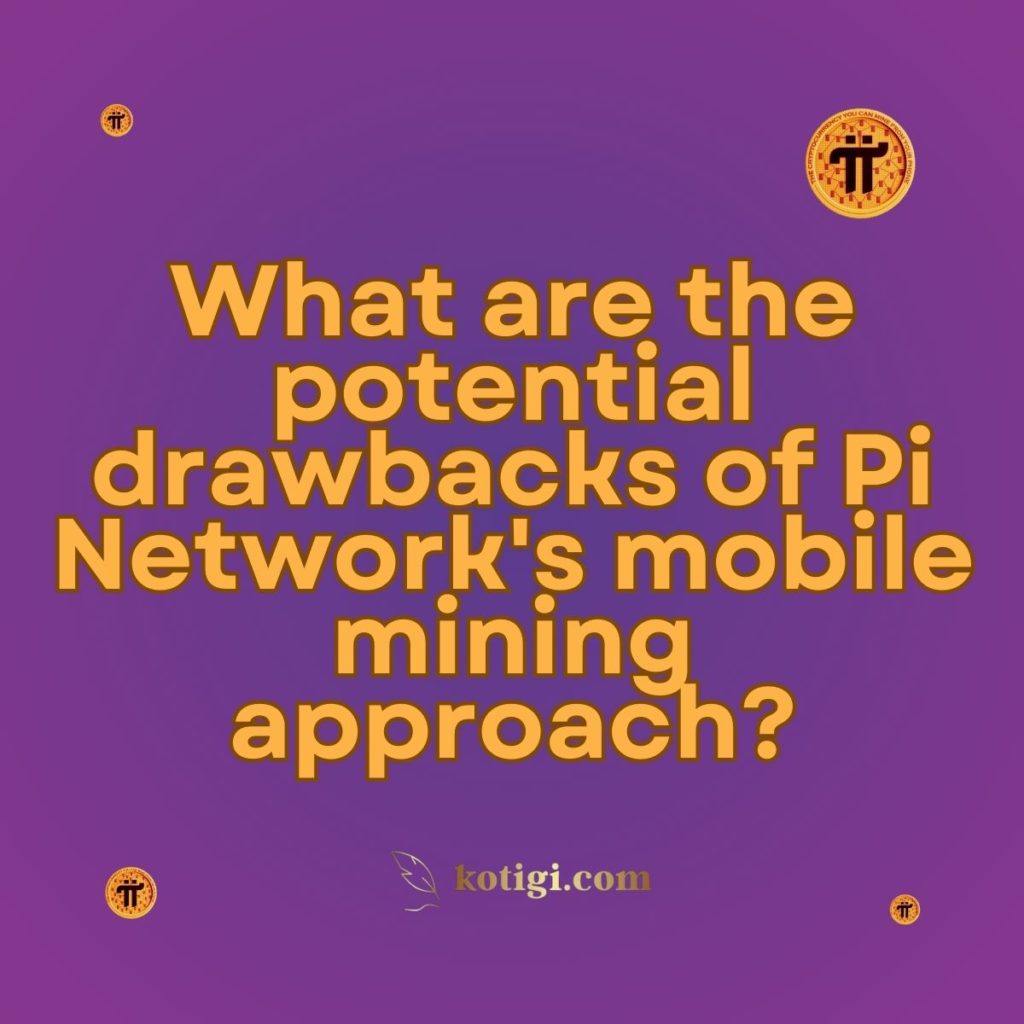
What are the potential drawbacks of Pi Network's mobile mining approach?
While Pi Network’s mobile mining approach democratizes access to cryptocurrency and enhances user engagement, it also presents several potential drawbacks. These include concerns about security, scalability, reliance on community trust, and the sustainability of the model in a competitive crypto landscape.
Introduction
As the cryptocurrency landscape continues to evolve, new projects are emerging with innovative solutions designed to make blockchain technology more accessible and user-friendly. One such initiative is Pi Network, which allows users to mine cryptocurrency directly from their mobile devices. This mobile mining approach aims to democratize access to cryptocurrency and engage a broader audience in the mining process.
However, while the concept is appealing, it is essential to examine the potential drawbacks of Pi Network’s mobile mining strategy. From security concerns and scalability issues to community trust and competition in the cryptocurrency space, this post will explore the various challenges and limitations associated with Pi Network’s mobile mining approach. Understanding these drawbacks is crucial for users, developers, and investors looking to navigate the evolving crypto landscape.
1. Overview of Pi Network
1.1 What is Pi Network?
Launched in 2019 by a team of Stanford graduates, Pi Network aims to provide a more inclusive platform for cryptocurrency mining. Unlike traditional cryptocurrencies that require significant hardware investments and energy consumption, Pi Network allows users to mine coins using their smartphones. By simplifying the mining process, the network seeks to attract a broader audience and build a strong community of users.
1.2 How Does Mobile Mining Work?
In Pi Network, users can mine coins by simply opening the app and pressing a button once every 24 hours. This process does not require extensive computational power or specialized hardware, making it accessible to anyone with a smartphone. Users are encouraged to build their networks by inviting friends and family, creating a sense of community and collaboration.
2. Security Concerns
2.1 Vulnerability to Attacks
Mobile devices are generally more vulnerable to security threats compared to traditional mining rigs. As users rely on their smartphones for mining, there is an increased risk of hacking, malware, and phishing attacks. If an attacker gains access to a user’s device, they could compromise their Pi Network account and potentially steal mined coins.
2.2 Lack of Robust Security Measures
While Pi Network employs the Stellar Consensus Protocol (SCP) to secure transactions, the overall security of the mobile mining process may not be as robust as traditional methods. Users may not have adequate knowledge about securing their devices, which can expose them to risks.
2.3 Trust in the Platform
Users must place a significant amount of trust in Pi Network as a platform. Any lapses in security or breaches can lead to skepticism about the integrity of the network, potentially undermining user confidence and participation.
3. Scalability Issues
3.1 Network Congestion
As Pi Network grows and attracts more users, network congestion could become a significant issue. While the Stellar Consensus Protocol is designed for efficiency, an influx of new miners may overwhelm the system, leading to slower transaction processing times and delays in confirmations.
3.2 Resource Limitations on Mobile Devices
Mobile devices generally have limited processing power compared to dedicated mining rigs. As the number of users increases, the demand for resources could strain the capabilities of mobile devices, leading to performance issues and reducing the overall mining experience.
3.3 Balancing Supply and Demand
With a rising number of users, Pi Network must carefully manage the balance between coin supply and demand. If too many coins are mined too quickly, it could lead to inflation, diminishing the value of each coin and potentially dissuading users from continuing to mine.
4. Community Trust and Reliability
4.1 Reliance on User Engagement
Pi Network’s success largely hinges on user engagement and participation. If users become disillusioned with the mining process or the perceived value of the coins, they may choose to disengage from the platform. A decline in active users can lead to reduced network activity and diminished value.
4.2 Building a Community of Trust
The community-driven aspect of Pi Network relies on building trust among users. However, trust can be easily compromised, especially in an environment where anonymity is prevalent. Instances of misinformation or negative experiences can lead to a breakdown of community cohesion.
4.3 Influence of Promoters and Influencers
The role of promoters and influencers in the Pi Network ecosystem can also impact community trust. If these individuals misrepresent the platform or provide misleading information, it can lead to inflated expectations and eventual disappointment among users.
5. Market Competition
5.1 Saturation of the Mobile Mining Market
The rise of mobile mining applications has led to an influx of similar projects in the cryptocurrency space. As competition intensifies, Pi Network may face challenges in distinguishing itself from other mobile mining platforms, potentially impacting its user base and growth prospects.
5.2 Innovative Alternatives
New technologies and approaches to mining are continuously emerging, which could overshadow Pi Network’s mobile mining model. As competitors develop more efficient or rewarding mining processes, users may gravitate toward these alternatives, undermining Pi Network’s growth.
5.3 Value Proposition
To remain competitive, Pi Network must continuously evaluate and enhance its value proposition. If users perceive that they can achieve better rewards or experiences through other platforms, Pi Network may struggle to retain its user base.
6. Regulatory Challenges
6.1 Evolving Regulations
The regulatory landscape for cryptocurrencies is continuously evolving, with many governments implementing stricter rules and guidelines. Pi Network may face regulatory scrutiny, particularly regarding its mobile mining approach and how it conducts its operations.
6.2 Compliance with Local Laws
As Pi Network expands globally, it must navigate various regulatory environments. Ensuring compliance with local laws and regulations can be complex and may pose challenges to its operations, affecting its ability to grow in certain regions.
6.3 Potential for Legal Challenges
If users encounter issues related to the platform’s operation or feel misled, it could result in legal challenges for Pi Network. Addressing these challenges can drain resources and impact the platform’s reputation.
7. Economic Viability
7.1 Sustainability of the Business Model
Pi Network’s mobile mining approach relies heavily on user participation to sustain its ecosystem. If user interest wanes or the perceived value of mined coins decreases, the economic viability of the platform could be threatened.
7.2 Inflationary Pressures
With a significant number of users mining coins simultaneously, there is a risk of inflation. If too many coins enter circulation without sufficient demand, it could diminish the value of Pi Network’s cryptocurrency, impacting users’ investments.
7.3 Funding and Development
To continue improving its platform and addressing user needs, Pi Network requires consistent funding and investment. Securing the necessary resources to support development can be challenging, especially in a competitive market.
8. User Experience and Interface
8.1 Simplicity vs. Complexity
While Pi Network aims to simplify the mining process, some users may find the app’s features and functionalities lacking compared to traditional mining platforms. Users seeking more advanced features or a richer experience may feel disappointed with the app’s offerings.
8.2 Learning Curve
Although the app is designed for ease of use, new users may still experience a learning curve in understanding how the platform works. Providing adequate resources and support is essential to ensure a positive user experience.
8.3 Technical Glitches
As with any mobile application, Pi Network is not immune to technical issues. Glitches, crashes, or slow response times can lead to frustration among users and may impact their willingness to engage with the platform.
9. Future Outlook
9.1 Adaptability to Change
The cryptocurrency market is characterized by rapid changes and technological advancements. Pi Network must remain adaptable to continue evolving its mobile mining approach and addressing emerging challenges.
9.2 Emphasis on Community Engagement
To overcome potential drawbacks, Pi Network should prioritize community engagement and communication. Actively involving users in decision-making processes and soliciting feedback can foster a sense of ownership and loyalty.
9.3 Innovations in Mining Technology
Pi Network has the opportunity to explore innovations in mining technology that could enhance its mobile mining approach. By integrating new features or partnerships, the platform can improve its offerings and remain competitive in the evolving landscape.
Conclusion:
Pi Network’s mobile mining approach represents an innovative step toward making cryptocurrency more accessible to a broader audience. However, several potential drawbacks warrant careful consideration. Security concerns, scalability issues, reliance on community trust, market competition, and regulatory challenges all pose risks to the long-term viability of the platform.
For users, developers, and investors, understanding these potential drawbacks is essential for navigating the evolving landscape of cryptocurrency. By addressing these challenges head-on and continually adapting to change, Pi Network can work toward realizing its vision of democratizing cryptocurrency mining while ensuring a sustainable and engaging ecosystem.
Key Takeaways:
- Pi Network’s mobile mining approach simplifies cryptocurrency access but raises security concerns related to mobile devices.
- Scalability issues may arise as user demand increases, leading to potential network congestion and resource limitations.
- Community trust and engagement are crucial for the platform’s success, but reliance on user participation can be a double-edged sword.
- Market competition poses a challenge as Pi Network must differentiate itself from other mobile mining platforms.
- Regulatory challenges may impact the platform’s operations and growth potential, requiring careful navigation of local laws.
- Economic viability and sustainability depend on maintaining user interest and managing inflationary pressures.
- User experience and interface design must balance simplicity with functionality to retain and attract users.





